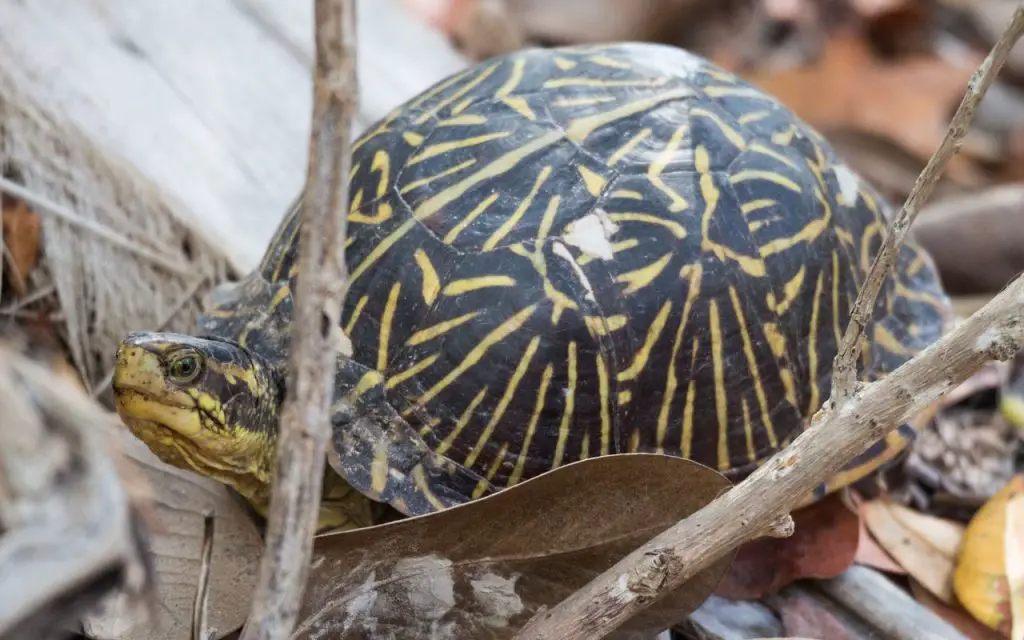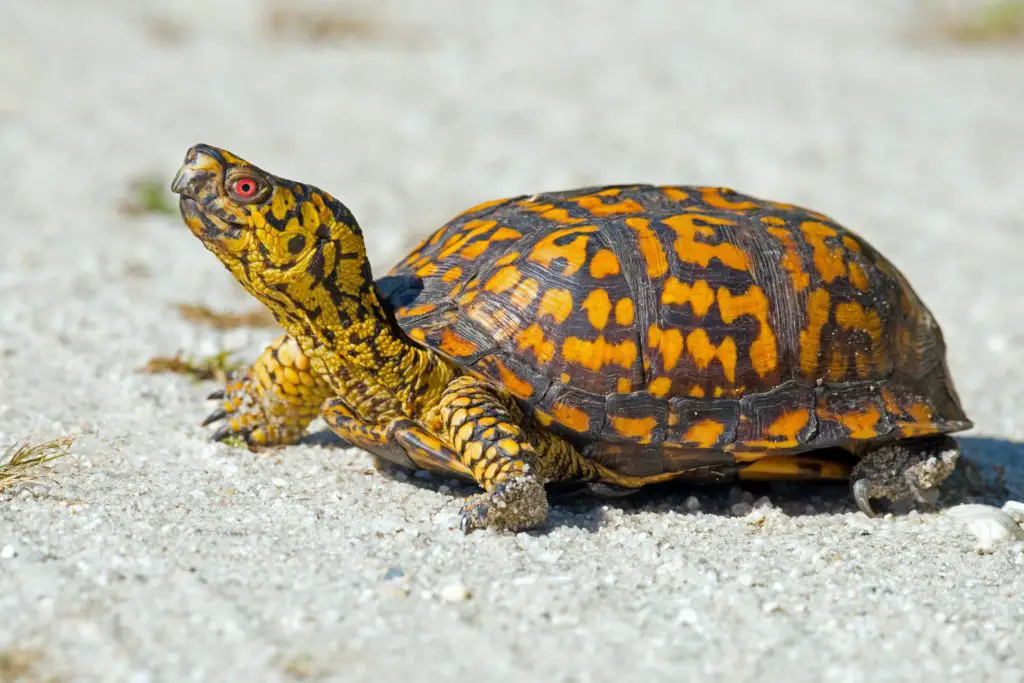Do Box Turtles need UVB? You bet they do. Let’s take a look at how they use UVB light, and how to give it to them in a captive setting…
Being active, diurnal foragers, box turtles do need UVB light to properly metabolize calcium and maintain their overall health. UVB light helps to produce vitamin D3 in the turtle’s skin, which is necessary for calcium absorption and bone growth. Without daily exposure to UV light, turtles develop metabolic bone disease – a deadly calcium deficiency.
It is vital to provide box turtles with a UVB light source for 10–12 hours per day. Otherwise, you’ll end up a with a severely deformed or even dead pet. In this article, we’ll take a look at some of the common questions surrounding UV lighting for Box Turtles.
Is turtle UVB light necessary? What for?
Yes, UVB light is necessary for box turtles. UVB light helps to produce vitamin D3 in the turtle’s skin, which is necessary for calcium metabolism, bone growth, and overall health.
Without UVB light, box turtles can develop metabolic bone disease, a condition where the bones become weak and brittle. It is recommended to provide box turtles with a UVB light source for 10–12 hours per day.
Let’s take a look at how exactly they use UV light. It happens in two steps:
1. Making Vitamin D3 from UVB
First, Turtles use UVB (and to a certain extent UVA) light to produce Vitamin D3. See table below…
| Step | Description |
|---|---|
| 1. | UVB Exposure: Turtles bask in the sun to expose themselves to ultraviolet B (UVB) radiation, which is necessary for vitamin D3 synthesis. |
| 2. | 7-Dehydrocholesterol Production: UVB radiation converts 7-dehydrocholesterol in the skin into pre-vitamin D3. |
| 3. | Pre-Vitamin D3 Formation: Pre-vitamin D3 spontaneously converts into vitamin D3 within the skin. |
| 4. | Transport to the Liver: Vitamin D3 is transported to the liver, where it is converted into 25-hydroxyvitamin D3 (25(OH)D3). |
| 5. | Transport to the Kidneys: 25(OH)D3 is transported to the kidneys, where it is converted into the active form of vitamin D3, 1,25-dihydroxyvitamin D3 (1,25(OH)2D3), by the action of the enzyme 1-alpha-hydroxylase. |
| 6. | Binding to Vitamin D Receptor: 1,25(OH)2D3 binds to the vitamin D receptor in target cells, regulating the expression of genes involved in calcium and phosphorus metabolism. |
2. Using the Vitamin D3 in calcium metabolism
Second, they use the Vitamin D3 to metabolise and use calcium. The following table shows how turtles use calcium (Vitamin D3 comes in at step 2.)
| Step | Description |
|---|---|
| 1. | Calcium Intake: Turtles obtain calcium primarily from their diet, which includes calcium-rich foods such as leafy greens and calcium supplements. |
| 2. | Calcium Absorption: Calcium is absorbed from the intestine into the bloodstream with the help of vitamin D3. |
| 3. | Calcium Transport: Calcium is transported in the bloodstream, either bound to proteins or as free ions. |
| 4. | Calcium Storage: Excess calcium is stored in the bones and shell. |
| 5. | Calcium Reabsorption: If calcium levels in the blood drop, calcium is reabsorbed from the bones and shell to maintain the proper blood calcium levels. |
| 6. | Calcium Excretion: Excess calcium is excreted primarily in the urine. |
UVA/UVB light for box turtles
Both UVA and UVB light are important for box turtles. UVA light is important for their mental and behavioral health. It provides them with a natural daylight spectrum, promoting normal activity levels, feeding behavior, and overall well-being.
UVB light, on the other hand, is necessary for proper calcium metabolism and overall health. It helps produce vitamin D3 in the turtle’s skin, which is necessary for calcium absorption and bone growth.
It is ideal to provide box turtles with a UVB light source for 10–12 hours per day, as well as full-spectrum UVA/UVB lighting.

Does a box turtle need a heat lamp?
Yes, box turtles need a heat lamp. Box turtles are poikilothermic and need to regulate their body temperature by basking in the heat. Often, they come out and bask first thing in the morning to get warmed up. In fact, this is how I spotted a few in the wild as a kid, by looking along the edges of forests early in the morning.
They need a heat lamp to provide a warm basking area in their enclosure, with a temperature of around 85-90 °F. This allows them to regulate their body temperature and maintain their overall health. *Note: you should always research the temperature for the specific species or subspecies you’re keeping: temperatures here are only broad guidelines.
It is also important to provide a suitable temperature gradient in their enclosure. The cooler area should be around 75 °F. This will enable them to move between warm and cool areas easily. To measure surface temperatures, I recommend using an infrared thermometer gun.

Do Box Turtles need a heat lamp at night?
No, Box Turtles do not typically need a heat lamp at night. They are naturally inactive during nighttime hours and do not require a heat source to regulate their body temperature.
The exception to the rule is if your house gets particularly cold during winter. In this case you’ll need to install a ceramice heat emitter to keep them warm overnight. Heat emitters generate warmth but no light, making them a great way to provide 24hr heat.
You will only need one of these if them temperature in your house drops below 75°F. In that case, I recommend getting a ceramic heat emitter and a clamp so you can suspend it above enclosure if its a tortoise table-type setup.
Or, if you’re using a vivarium, it will need mounting to the ceiling, just like a heat lamp. In either case, you’ll need a pulse-proportional thermost to regulate it.
If you do decide to use a ceramic heat emitter, remember that you can use it during the day too for a basking spot. In that scenario, you won’t need a heat lamp for your pet, just the emitter and a separate UV bulb.

What kind of bulb does a box turtle need?
For a box turtle, it is recommended to use a combination of two types of bulbs: a heat lamp and a UVB light source. You can either buy one of each, or buy one that combines the two (usually much more expensive).
The heat lamp should be a basking bulb that provides infrared heat and raises the temperature in the basking area to around 85-90 °F. A ceramic heat emitter or a red heat bulb can be used for this purpose. *Note: you should always research the temperature for the specific species or subspecies you’re keeping: temperatures here are only broad guidelines.
The UVB light source should emit UVB radiation, which is essential for proper calcium metabolism and overall health in box turtles. A fluorescent bulb specifically designed for reptiles can be used to provide UVB light.
It is essential to position the UVB bulb close enough to the turtle. That way it can receive the UVB light effectively, without any possibility of physical damage.
Make sure to replace the UVB bulb every 6–9 months, as the UVB output decreases over time. I know some manufacturers say 9-12 months, but I’d rather play it safe!
When choosing a UV bulb, you should opt for a UV 10 bulb, that will give optimum light at ground level where your pet basks. So, if your enclosure is 12inches tall, you need a bulb that radiates and adequate amount of UVB to that distance.
Check out this lighting table from ZooMed that will help you choose the correct bulb. I recommend one that provides “Zone 3” light at the correct distance for your setup. *The “Powersun” 80/100/160 watt bulbs are all-in-one options.

Box turtle heat lamp wattage
The wattage of the heat lamp for a box turtle depends on several factors. These factors include – the size of the enclosure, the ambient temperature in the room, and the desired temperature gradient within the enclosure.
As a general guideline, a 60-75 watt heat bulb should be sufficient for a 20-gallon enclosure, while a 100-watt bulb may be needed for a larger enclosure. It is important to monitor the temperature in the basking area regularly to ensure that it stays within the appropriate range of 85-90 °F.
A thermometer or a temperature gun can be used to measure the temperature. It is also important to provide a cooler area in the enclosure, with a temperature of around 75 °F.
This will allow the turtle to properly maintain its body heat. This can be achieved by positioning the heat lamp in a specific area of the enclosure and providing shade or ventilation in other areas.
Don’t forget that excessive heat is bad for a turtle’s health. Most scientists agree that excessive UVA radiation can strip vitamin A from Turtle skin..
Do Eastern box turtles need UVB light?
Yes, Eastern box turtles need UVB light. In the wild, they often spend time in shady areas, but that doesn’t mean they don’t bask. In fact, you’ll find them basking and foraging in sunlight at various points during the day.
Exposure to UVB light source for 10–12 hours per day can have several health benefits for these turtles. Some of these health benefits are as follows:
- Proper calcium metabolism: UVB light helps produce vitamin D3 in the turtle’s skin, which is necessary for calcium absorption and bone growth.
- Better overall health: UVB light promotes overall health by allowing the turtle to properly metabolize calcium, which is essential for many physiological processes – not just maintaining their skeleton
- Normal behavior and activity levels: UVB light, along with UVA light, provides a natural daylight spectrum that promotes normal activity levels and feeding behavior.
- Better immune system function: UVB light helps boost the turtle’s immune system, which is essential for fighting off infections and diseases.

Do box turtles need water in their tank?
Yes, box turtles need access to water in their enclosure at all times. Most North American Box Turtles (that means the subspecies of Common Box Turtle: Eastern, Gulf Coast, etc.) spend a decent amount of time foraging in humid environments, and will bathe in shallow water every day.
Even the Desert Box Turtle (Terrapene ornata luteola) enjoys having a shallow dish of water available. They might come from out west, but they always stay close to water or humid soil if given the chance.
The water should be kept clean and changed regularly to prevent the buildup of harmful bacteria. The size of the water dish should be large enough for the turtle to fully enter and move around. A shallow dish around 12x12inches is ideal, with about 1inch of water in it.
For Eastern, Florida, Three Toed and Gulf Coast Box Turtles, it is also important to mist the enclosure regularly to provide additional hydration. This will increase the humidity levels in the enclosure, which is essential for the turtle’s overall health and well-being.

How do I keep my box turtle warm at night?
To keep your box turtle warm at night, you can do the following:
- Maintain the right temperature with a nighttime heat source: Keep the temperature in the turtle’s enclosure within the appropriate range (75 °F +/- a few degrees) by using a ceramic heat emitter.
- Provide insulation: Insulate the turtle’s enclosure to help maintain the temperature, especially in cooler rooms or during the winter months. This can be done by using a foam insulation board, a space blanket, or additional bedding material.
- Use a thermostat: Use a thermostat to regulate the temperature in the turtle’s enclosure and ensure that it stays within the appropriate range, even at night.
- Place the enclosure in a warm room: Place the turtle’s enclosure in a warm room, away from windows and drafts. This will help to maintain the temperature and prevent it from dropping too low at night.
It is important to monitor the temperature in the turtle’s enclosure regularly and make any necessary adjustments to ensure that the turtle stays warm and comfortable at night.

How much UVB does a box turtle need?
Box turtles need access to UVB light for 10–12 hours per day to maintain their health. It is important to provide them with a full-spectrum UVB light that emits UVB in the appropriate range (290-320 nm) to ensure they receive enough UVB to produce vitamin D3.
The distance between the UVB light and the turtle should be appropriate, as the UVB light intensity decreases with distance. As a general guideline, the UVB light should be positioned about 12–18 inches above the basking area and replaced every 6–9 months.
Best UVB bulb for a box turtle
Several options for UVB bulbs that are suitable for box turtles include:
- T5 HO UVB bulb: T5 HO (High Output) UVB bulbs are a popular option for box turtle owners. They emit both UVB and UVA light and are designed to be used with T5 fixtures.
- Mercury vapor bulb: Mercury vapor bulbs emit both UVB and UVA light and are one of the most powerful UVB sources available. Several major brands make these bulbs, including NeoRep and Zoo Med. You can easily find them on eBay or Amazon.
- Compact fluorescent UVB bulb: Compact fluorescent UVB bulbs are a compact and efficient option for box turtle owners. They emit both UVB and UVA light and are designed to be used with compact fluorescent fixtures.
Regardless of the type of bulb you choose, it is important to ensure that it is rated for reptile use. It should emit UVB in the appropriate range (290-320 nm) to ensure that it provides the necessary UVB for your box turtle’s health. It’s always best to check the manufacturer guidelines.

FAQs relating to box turtles and UVB light
What temperature is too cold for box turtles?
Box turtles are cold-blooded reptiles and rely on their environment to regulate their body temperature. Generally, temperatures below 70 °F are considered too cold for box turtles. At these temperatures, box turtles can become sluggish and inactive, which can lead to a weakened immune system and decreased appetite. Moreover, temperatures below 50 °F can be dangerous and can lead to metabolic issues and even death.
What do box turtles do all day?
Box turtles are active during the day and spend their time performing a variety of activities. They spend time basking in the sun to regulate their body temperature and absorb UVB radiation, which is important for their health.
They also forage for food, such as plants, insects, and small invertebrates, and engage in exploratory behavior. When they feel threatened, box turtles may retreat into their shell for protection.
At night, they typically find a safe place to rest and become less active. In captive settings, box turtles may exhibit similar behaviors, but it’s important to provide them with a suitable environment that meets their physical and behavioral needs.
What does a box turtle need in its cage?
Box turtles need a suitable habitat that meets their physical and behavioral needs in captivity. They require – an enclosure, a substrate, lighting, heating, water, and a place to hide.
What is good bedding for box turtles?
Several bedding options that are suitable for box turtles include – coconut coir, soil, Cypress mulch, and paper-based bedding. If you use anything material from outdoors for bedding (like soil) be sure to sterilise it by baking before adding it to the enclosure.
Key Takeaways
- Box turtles need UVB light to properly metabolize calcium and maintain their health.
- It is necessary to provide them with a UVB light source for 10–12 hours daily.
- They do not typically need a heat lamp at night.
- The UVB range (290-320 nm) is optimal for a box turtle’s health.
- Temperatures below 70 °F can be bad for these turtles.

